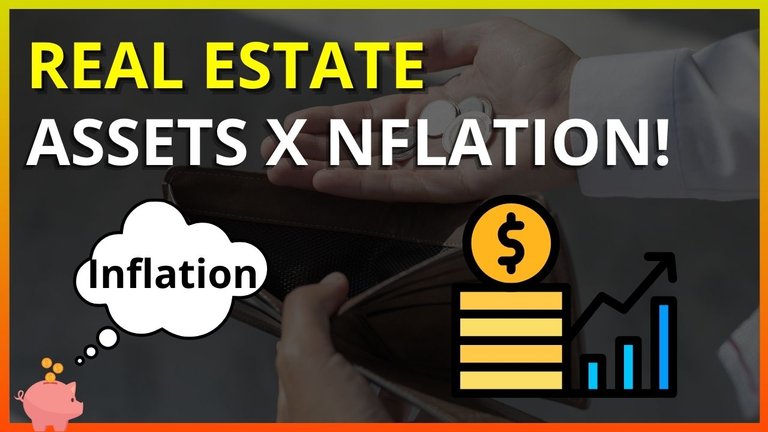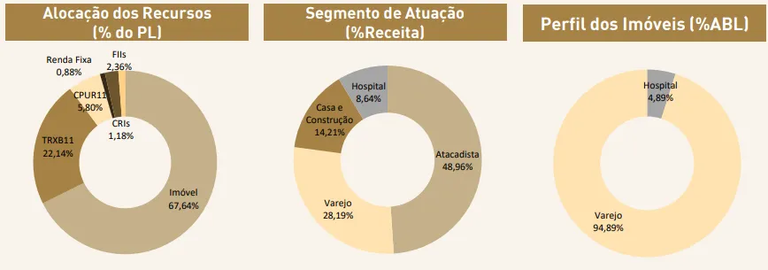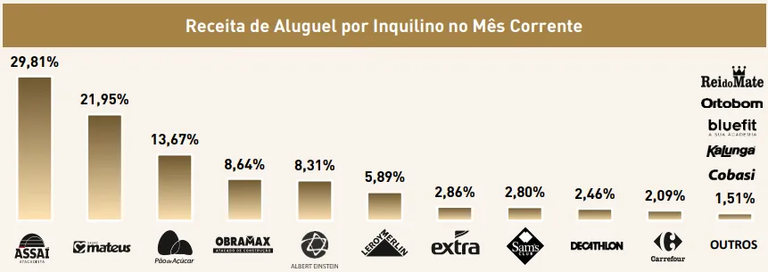Real Estate 🏘️| Asset Types for Inflationary Periods! [EN/PT]

Inflation is the general increase in prices and in a scenario of continuous increase in inflation rates in general, around the world, people wonder what type of investment is capable of taking advantage of moments like this. In this sense, one class of assets that can “absorb” part of this increase in prices is real estate, especially physical real estate that increases in price over time.
In addition, there are also other assets that have their return linked to inflation plus a rate, but of course they run the risk of losing profitability with the fall of this rate. Curious to know more about this subject? Come and discover some examples of real estate funds that are a type of asset that benefits from inflation.
I'll be much appreaciated if you Upvote, Reblogs or give any Tips ( PIZZA 🍕, PGM 🎮, LOLZ 😆, ALIVE ❤️, etc ). Thanks and have good reading! 🍀

[ENGLISH VERSION]
TRXF11 - Retail Real Estate Fund 📊

A real estate fund segment that is generally not much talked about is the Retail sector. TRXF11 is a real estate fund in this segment, with a total of 58 assets spread across Brazil. Among its tenants, the main areas of activity are wholesalers with 48.96%, followed by Retail with 28.19%, then 14.21% of Home and Construction and finally 8.64% Hospital. Recently, its active management sold a leased property to Assaí for R$69 million, generating an estimated profit of R$7.1 million, which would represent 131.69% of the CDI return on this property from the acquisition to the sale. Furthermore, in addition to selling, the fund made the 11th Offering of Issuance of Shares on the 26th with the intention of raising R$1 billion, which would represent a 49.29% growth in the fund's equity, reducing leverage by almost 10%.

This is a positive point of actively managed funds, which take advantage of good opportunities to sell real estate to guarantee profit for the fund's shareholders and acquisitions with better profitability. However, it is always important to be aware of the risks, as the fund has 67.64% allocated to real estate, the risk related to inflation is reduced. However, its concentration of almost 50% in 2 tenants, Assaí and Grupo Matheus, is a warning sign, since if something happens and they stop paying the rent, it would represent a large part of the revenue. Perhaps with the new issuance, the exposure to certain tenants will decrease.
What are Multistrategy FIIs? 🏠

Multi-strategy funds, or hedge funds, are more flexible versions of Funds of Funds (FoFs), which allow the manager to allocate the fund's capital across a greater diversity of assets, ranging from FIIs to Stocks if I'm not mistaken, unlike FoFs, which generally have allocations made only in shares of other FIIs and cash. While this high level of flexibility gives the manager greater allocation freedom, on the other hand, it ends up demanding more from the manager and thus giving greater weight to the manager behind the fund.
As for the shareholder, when choosing a multi-strategy fund, he ends up trusting active management to identify opportunities and market analysis to bring maximum gains to the fund, because instead of making decisions and carrying out these analyses, he delegates this management function to the group responsible for the fund. An interesting piece of information is that hybrid funds have stood out in terms of average performance, with a return of 17.21%. I believe that multi-strategy funds end up being part of this segment. One of the reasons for this return may come precisely from the ability to assemble more diversified portfolios, bringing in more capital gains that increase this return.


Inflação é o aumento geral de preços e e um cenário de contínua elevação das taxas inflação de forma geral, ao redor do mundo, as pessoas se perguntam qual tipo de investimento é capaz de aproveitar de momentos como esse. Nesse sentido, uma classe de ativos que consegue “absorver” uma parte dessa alta dos preços são os imóveis, principalmente os físicos que aumentam de preço ao longo do tempo.
Além disso, existem também outros ativos que tem seu retorno atrelado à inflação mais uma taxa, mas claro correm o risco de perderem rentabilidade com a queda dessa taxa. Curioso para saber mais sobre esse assunto? Venha descobrir alguns exemplos de fundos imobiliários que são um tipo de ativo que se beneficia da inflação.
Fico agradecido se você puder dar um Upvote, Reblogs ou algum Tips ( PIZZA 🍕, PGM 🎮, LOLZ 😆, ALIVE ❤️, etc ). Obrigado e boa leitura! 🍀

[VERSÃO PORTUGUÊS]
TRXF11 - Fundo Imobiliário de Varejo 📊

Um segmento de fundo imobiliário que geralmente não é muito comentado é o setor de Varejo. O TRXF11 é um fundo imobiliário desse segmento, tendo um total de 58 ativos espalhados pelo brasil. Dentre os seus inquilinos, as principais áreas de atuação são atacadistas com 48,96%, seguidas pelo Varejo com 28,19%, depois 14,21% de Casa e Construção e por fim 8,64% Hospital. Recentemente a sua gestão ativa realizou a venda de um imóvel alugado para o Assaí por R$69 milhões., gerando um lucro estimado de R$7,1 milhões, o que representaria 131,69% do CDI de retorno desse imóvel desde a aquisição até essa venda. Ainda, além de vender, o fundo fez a 11ª Oferta de Emissão de Cotas no dia 26 com intenção de captar R$1 Bilhão, o que representaria um crescimento de 49,29% do patrimônio do fundo, reduzindo a alavancagem em quase 10%.

Esse é um ponto positivo de fundos com gestão ativa, que aproveitam as boas oportunidades de venda imóveis para garantir lucro para os cotistas do fundo imobiliário e aquisições com melhor rentabilidade. Entretanto, é sempre importante ficar ligado aos riscos, como o fundo possui 67,64% alocado em imóveis, o risco relacionado à inflação reduz. Mas, a sua concentração de quase 50% em 2 inquilinos o Assaí e o Grupo Matheus é um ponto de alerta, já que se algo acontecer e eles deixarem de pagar o aluguel, representaria uma grande parte da receita. Talvez com a nova emissão, a exposição à certo inquilinos diminua.
O que são Fiis Multiestratégia? 🏠

Os fundos multiestratégia, ou hedge funds, são versões mais flexíveis dos Fundos de Fundos (FoFs), que permitem ao gestor realizar a alocação de capital do fundo em uma maior diversidade de ativos, podendo ir de FIIs até Ações se não me engano, diferente dos FoF, que geralmente tem alocações feitas em apenas cotas de outros FIIs e caixa. Se por um lado essa flexibilidade elevada dá ao gestor uma maior liberdade de alocação, por outro ela acaba exigindo mais do gestor e dando assim um peso maior para a gestora que está por trás do fundo.
Já para o cotista, ao escolher um fundo multiestratégia ele acaba confiando na gestão ativa em identificar oportunidades e analise de mercado para trazer o máximo de ganhos para o fundo, porque ao em vez de tomar as decisões e fazer essas análises, ele delega essa função de gestão para o grupo responsável pelo fundo. Um informação interessante é que os fundos híbridos tem se destacado em termos de performance média com 17,21% de retorno, acredito que os multiestratégias acabam fazendo parte desse segmento. Um dos motivos desse retorno pode vir justamente da capacidade de montar carteiras mais diversificadas, trazendo mais ganhos de capital que fazem esse retorno subir.


If you like Crypto, Play2Earn, Finance or Anime content, consider FOLLOW me, that way you'll receive a notification when new post is done.
Thank you for reading. See ya! 👋👋
Posted Using INLEO
Obrigado por promover a comunidade Hive-BR em suas postagens.
Vamos seguir fortalecendo a Hive